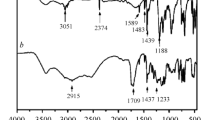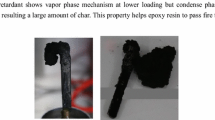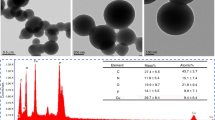Abstract
A phosphorus-nitrogen containing flame retardant additive of polyphosphoric acid piperazine, defined as PPAP, was synthesized by the salt-forming reaction between anhydrous piperazine and phosphoric acid, and the dehydration polymerization under heating in nitrogen atmosphere. Its chemical structure was well characterized by Fourier transform infrared (FTIR) spectroscopy, 13C and 31P solid-state nuclear magnetic resonance measurements. The synthesized PPAP and curing agent m-phenylenediamine were blended into epoxy resin (EP) to prepare flame retardant EP thermosets. The effects of PPAP on the fire retardancy and thermal degradation behavior of cured EP/PPAP composites were investigated by limiting oxygen index (LOI), vertical burning (UL-94), thermogravimetric analysis/infrared spectrometry (TG-IR) and cone calorimeter tests. The morphologies and chemical compositions of char residues for cured epoxy resin were investigated by scanning electron microscopy (SEM) and X-ray photoelectron spectroscopy (XPS), respectively. The results demonstrated that the flame retardant EP thermosets successfully passed UL-94 V-0 flammability rating and the LOI value was as high as 30.8% when incorporating 5wt% PPAP into the EP thermosets. The TGA results indicated that the synthesized PPAP flame retardant additive possessed high thermal stability and excellent charring capability. Meanwhile, the incorporation of PPAP stimulated the epoxy resin matrix to decompose and charring ahead of time due to its catalytic decomposition effect, which led to a higher char yield at high temperature. The morphological structures and the analysis results of XPS for char residues of EP thermosets revealed that the introduction of PPAP benefited the formation of a sufficient, more compact and homogeneous char layer containing phosphorus-nitrogen flame retardant elements on the material surface during combustion. The formed char layer with high quality effectively prevented the heat transmission and diffusion, limited the production of combustible gases, and inhibited the emission of smoke, leading to the reduction of heat and smoke release.
Similar content being viewed by others
References
Wang, X.; Song, L.; Xing, W. Y.; Lu, H. D.; Hu, Y. An effective flame retardant for epoxy resins based on poly(DOPO substituted dihydroxyl phenyl pentaerythritol diphosphonate). Mater. Chem. Phys. 2011, 125(3), 536–541.
Chen, Z. K.; Yang, G.; Yang, J. P.; Fu, S. Y.; Ye, L.; Huang, Y. G. Simultaneously increasing cryogenic strength, ductility and impact resistance of epoxy resins modified by n-butyl glycidyl ether. Polymer 2009, 50(5), 1316–1323.
Toldy, A.; Szabó, A.; Novák, C.; Madarász, J.; Tóth, A.; Marosi, G. MarosiIntrinsically flame retardant epoxy resin-fire performance and background-Part II. Polym. Degrad. Stab. 2008, 93(11), 2007–2013.
Gao, M.; Wu, W. H.; Xu, Z. Q. Thermal degradation behaviors and flame retardancy of epoxy resins with novel silicon-containing flame retardant. J. Appl. Polym. Sci. 2013, 127(3), 1842–1847.
Kandola, B. K.; Biswas, B.; Price, D.; Horrocks, A. R. Studies on the effect of different levels of toughener and flame retardants on thermal stability of epoxy resin. Polym. Degrad. Stab. 2010, 95(2), 144–153.
Levchik, S. V.; Weil, E. D. A review of recent progress in phosphorus-based flame retardants. J. Fire Sci. 2006, 24(5), 345–364.
Lin, H. T.; Lin, C. H.; Hu, Y. M.; Su, W. C. An approach to develop high-T g epoxy resins for halogen-freecopper clad laminates. Polymer 2009, 50(24), 5685–5692.
Braun, U.; Balabanovich, A. I.; Schartel, B.; Knoll, U.; Artner, J.; Ciesielski, M.; Hoffmann, T. Influence of the oxidation state of phosphorus on the decomposition and fire behaviour of flame-retarded epoxy resin composites. Polymer 2006, 47, 8495–8508.
Ren, H.; Sun, J. Z.; Wu, B. J.; Zhou, Q. Y. Synthesis and properties of a phosphorus-containing flame retardant epoxy resin based on bis-phenoxy(3-hydroxy) phenyl phosphine oxide. Polym. Degrad. Stab. 2007, 92(6), 956–961.
Li, Y.; Zheng, H. B.; Xu, M. J.; Li, B.; Lai, T. Synthesis of a novel phosphonate flame retardant and its application in epoxy resins. J. Appl. Polym. Sci. 2015, 132(45), 13085–13094.
Xu, M. J.; Xu, G. R.; Leng, Y.; Li, B. Synthesis of a novel flame retardant based on cyclotriphosphazene and DOPO groups and its application in epoxy resins. Polym. Degrad. Stab. 2016, 123, 105–114.
Xu, M. J.; Zhao, W.; Li, B. Synthesis of a novel curing agent containing organophosphorus and its application in flame-retarded epoxy resins. J. Appl. Polym. Sci. 2014, 131(23), 12406–12417.
Martin, C.; Lligadas, G.; Ronda, J. C.; Galia, M.; Cadiz, V. Synthesis of novel boron-containing epoxy-novolac resins and properties of cured products. J. Polym. Sci., Part A: Polym. Chem. 2006, 44(21), 6332–6344.
Dogan, M.; Unlu, S. M. Flame retardant effect of boron compounds on red phosphorus containing epoxy resins. Polym. Degrad. Stab. 2014, 99, 12–17.
Zhang, T.; Liu, W.; Wang, M.; Liu, P.; Pan, Y.; Liu, D. Synthesis of a boron/nitrogen-containing compound based on triazine and boronic acid and its flame retardant effect on epoxy resin. High. Perform. Polym. 2016, DOI: 10.1177/0954008316650929.
Unlu, S. M.; Dogan, S. D.; Dogan, M. Comparative study of boron compounds and aluminum trihydroxide as flame retardant additives in epoxy resin. Polym. Adv. Technol. 2014, 25(8), 769–776.
Canadell, J.; Mantecon, A.; Cadiz, V. Copolymerization of a silicon-containing spiroorthoester with a phosphorus-containing diglycidyl compound: influence on flame retardancy and shrinkage. Polym. Degrad. Stab. 2007, 92(10), 1934–1941.
Mercado, L. A.; Galia, M.; Reina, J. A. Silicon-containing flame retardant epoxy resins: synthesis, characterization and properties. Polym. Degrad. Stab. 2006, 91(11), 2588–2594.
Song, S.; Ma, J.; Cao, K.; Chang, G.; Huang, Y.; Yang, J. Synthesis of a novel dicyclic silicon-/phosphorus hybrid and its performance on flame retardancy of epoxy resin. Polym. Degrad. Stab. 2014, 99, 43–52.
Qian, X.; Song, L.; Bihe, Y.; Yu, B.; Shi, Y.; Hu, Y.; Yuen, R. K. Organic/inorganic flame retardants containing phosphorus, nitrogen and silicon: preparation and their performance on the flame retardancy of epoxy resins as a novel intumescent flame retardant system. Mater. Chem. Phys. 2014, 143(3), 1243–1252.
Wang, S.; Xin, F.; Chen, Y.; Qian, L.; Chen, Y. Phosphorus-nitrogen containing polymer wrapped carbon nanotubes and their flame-retardant effect on epoxy resin. Polym. Degrad. Stab. 2016, 129, 133–141.
Zhang, X. H.; Liu, F.; Chen, S.; Qi, G. R. Novel flame retardant thermosets from nitrogen-containing and phosphoruscontaining epoxy resins cured with dicyandiamide. J. Appl. Polym. Sci. 2007, 106(4), 2391–2397.
Gu, L.; Chen, G.; Yao, Y. Two novel phosphorus-nitrogencontaining halogen-free flame retardants of high performance for epoxy resin. Polym. Degrad. Stab. 2014, 108, 68–75.
Artner, J.; Ciesielski, M.; Walter, O.; Doring, M.; Perez, R. M.; Sandler, J. K. W.; Altstadt, V.; Schartel, B. A novel DOPO-based diamine as hardener and flame retardant for epoxy resin systems. Macromol. Mater. Eng. 2008, 293(6), 503–514.
Alcon, M. J.; Ribera, G.; Galia, M.; Cadiz, V. Advanced flame retardant epoxy resins from phosphorus-containing diol. J. Polym. Sci., Part A: Polym. Chem. 2005, 43, 3510–3515.
Lu, S. Y.; Hamerton, I. Recent developments in the chemistry of halogen-free flame retardant polymers. Prog. Polym. Sci. 2002, 27, 1661–1712.
Duquesne, S.; Lefebvre, J.; Seeley, G.; Camino, G.; Delobel, R.; Lebras, M. Vinyl acetate/butyl acrylate copolymers: Part 2: fire retardancy using phosphorus-containing additives and monomers. Polym. Degrad. Stab. 2004, 85(2), 883–892.
Perret, B.; Schartel, B.; Stöß, K.; Ciesielski, M.; Diederichs, J.; Döring, M.; Krämer, J.; Altstädt, V. A new halogen-free flame retardant based on 9,10-dihydro-9-oxa-10-phosphaphenanthrene-10-oxide for epoxy resins and their carbon fiber composites for the automotive and aviation industries. Macromol. Mater. Eng. 2011, 296, 14–30.
Yang, S.; Wang, J.; Huo, S.; Wang, M.; Tang, Y. Synthesis of a phosphorus/nitrogen-containing compound based on maleimide and cyclotriphosphazene and its flame-retardant mechanism on epoxy resin. Polym. Degrad. Stab. 2016, 126, 9–16.
Yang, S.; Wang, J.; Huo, S.; Wang, M. Preparation and flame retardancy of a compounded epoxy resin system composed of phosphorus/nitrogen-containing active compounds. Polym. Degrad. Stab. 2015, 121, 398–406.
Gao, M.; Yang, S. S. A novel intumescent flame-retardant epoxy resins system. J. Appl. Polym. Sci. 2010, 113(4), 2346–2351.
Xu, M. J.; Ma, Y.; Hou, M. J.; Li, B. Synthesis of a cross-linked triazine phosphine polymer and its effect on fire retardancy, thermal degradation and moisture resistance of epoxy resins. Polym. Degrad. Stab. 2015, 119, 14–22.
Yang, K.; Xu,, M. J.; Li, B. Synthesis of N-ethyl triazine-piperazine copolymer and flame retardancy and water resistance of intumescent flame retardant polypropylene. Polym. Degrad. Stab. 2013, 98(7), 1397–1406.
Tan, Y.; Shao, Z. B.; Yu, L. X.; Long, J. W.; Qi, M.; Chen, L.; Wang, Y. Z. Piperazine-modified ammonium polyphosphate as monocomponent flame-retardant hardener for epoxy resin: flame retardance, curing behavior and mechanical property. Polym. Chem. 2016, 7(17), 3003–3012.
Nguyen, T. M.; Chang, S. C.; Condon, B.; Thomas, T. P.; Azadi, P. Thermal decomposition reactions of cotton fabric treated with piperazine-phosphonates derivatives as a flame retardant. J. Anal. Appl. Pyrolysis. 2014, 110, 122–129.
Gao, M.; Wo, Y. Q.; Wu, W. H. Microencapsulation of intumescent flame-retardant agent and application to epoxy resins. J. Appl. Polym. Sci. 2011, 119, 2025–2030.
Gao, L. P.; Wang, D. Y.; Wang, Y. Z. A flame-retardant epoxy resin based on a reactive phosphorus-containing monomer of DODPP and its thermal and flame-retardant properties. Polym. Degrad. Stab. 2008, 93(7), 1308–1315.
Zhang, W.; Li, X.; Yang, R. J. Pyrolysis and fire behaviour of epoxy resin composites based on a phosphorus-containing polyhedral oligomeric silsesquioxane (DOPO-POSS). Polym. Degrad. Stab. 2011, 96(10), 1821–1832.
Yang, S.; Wang, J.; Huo, S. Q.; Wang, M.; Zhang, B. Synergistic flame-retardant effect of expandable graphite and phosphorus-containing compounds for epoxy resin: strong bonding of different carbon residues. Polym. Degrad. Stab. 2016, 128, 89–98.
Acknowledgments
This work was financially supported by the Fundamental Research Funds for the Central Universities (No. 2572014EB06-02), the National Natural Science Foundation of China (No. 51673035) and Heilongjiang Major Research Projects (No. GA15A101).
Author information
Authors and Affiliations
Corresponding author
Rights and permissions
About this article
Cite this article
Xu, MJ., Xia, SY., Liu, C. et al. Preparation of Poly(phosphoric acid piperazine) and Its Application as an Effective Flame Retardant for Epoxy Resin. Chin J Polym Sci 36, 655–664 (2018). https://doi.org/10.1007/s10118-018-2036-8
Received:
Accepted:
Published:
Issue Date:
DOI: https://doi.org/10.1007/s10118-018-2036-8




